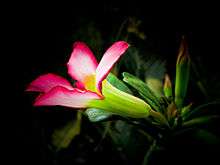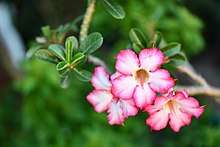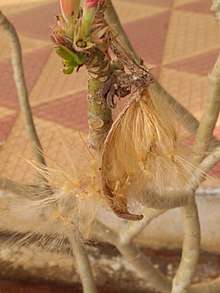Adenium
Adenium is a genus of flowering plants in the family Apocynaceae first described as a genus in 1819. It is native to Africa and the Arabian Peninsula.[3]
| Adenium | |
|---|---|
 | |
| An Adenium flower | |
| Scientific classification | |
| Kingdom: | Plantae |
| Clade: | Tracheophytes |
| Clade: | Angiosperms |
| Clade: | Eudicots |
| Clade: | Asterids |
| Order: | Gentianales |
| Family: | Apocynaceae |
| Subfamily: | Apocynoideae |
| Tribe: | Nerieae |
| Genus: | Adenium Roem. & Schult.[1] |
| Synonyms[2] | |
| |
Cultivation and uses

Adenium obesum is grown as a houseplant in temperate regions. Numerous hybrids have been developed. Adeniums are appreciated for their colorful flowers, but also for their unusual, thick caudices. They can be grown for many years in a pot and are commonly used for bonsai.

Because seed-grown plants are not genetically identical to the mother plant, desirable varieties are commonly propagated by grafting. Genetically identical plants can also be propagated by cutting. However, cutting-grown plants do not tend to develop a desirable thick caudex as quickly as seed-grown plants.
The sap of Adenium boehmianum, A. multiflorum, and A. obesum contains toxic cardiac glycosides and is used as arrow poison throughout Africa for hunting large game.[4]
Classification
The genus Adenium has been held to contain as many as twelve species. These are considered by other authors to be subspecies or varieties. A late-20th-century classification by Plazier recognizes five species.[5]
- Species[3]
- Adenium arabicum Balf.f. = A. obesum
- Adenium boehmianum Schinz - (Namibia, Angola)
- Adenium multiflorum Klotzsch. (Southern Africa, from Zambia south)
- Adenium obesum (Forssk.) Roem. & Schult. - widespread from Senegal to Somalia, and also Arabian Peninsula
- Adenium oleifolium Stapf - South Africa, Botswana, Namibia
- Adenium swazicum Stapf (Eastern South Africa)[5][6]
- Formerly placed here
- Pachypodium namaquanum (Wyley ex Harv.) Welw. (as A. namaquanum Wyley ex Harv.)[6]
Common names
Adenium obesum is also known as the desert rose. In the Philippines, due to its resemblance to the related genus Plumeria, and the fact that it was introduced to the Philippines from Bangkok, Thailand, the plant is also called as Bangkok kalachuchi.
Due to its resemblance to a miniature frangipani tree and its popularity in bonsai, it is also sometimes known as Japanese frangipani.
References
- "Genus: Adenium Roem. & Schult". Germplasm Resources Information Network. United States Department of Agriculture. 2003-03-14. Archived from the original on 2012-10-06. Retrieved 2010-06-26.
- "World Checklist of Selected Plant Species".
- Kew World Checklist of Selected Plant Families
- Schmelzer, G.H.; A. Gurib-Fakim (2008). Medicinal Plants. Plant Resources of Tropical Africa. pp. 43–49. ISBN 978-90-5782-204-9.
- Stoffel Petrus Bester (June 2004). "Adenium multiflorum Klotzsch". South African National Biodiversity Institute's plant information website.
- "GRIN Species Records of Adenium". Germplasm Resources Information Network. United States Department of Agriculture. Archived from the original on 2015-09-24. Retrieved 2010-06-26.
External links
| Wikimedia Commons has media related to Adenium. |
| Wikispecies has information related to Adenium |